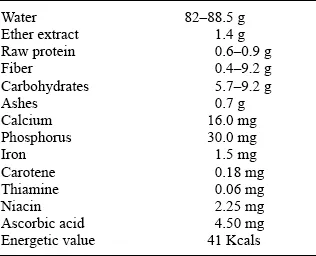1.1.1 Origin, botany, morphology and structure
Cocona (Solanum sessiliflorum) is native to the eastern slopes of the Andes of Peru, Ecuador, Colombia and Venezuela as well as the Amazonian part of Brazil. It belongs to the Solanaceae and the genus Solanum. At present it is named Solanum sessiliflorum but was previously known as Solanum topiro and earlier as Solanum hyporrhodium. In Spanish it is called cocona, topiro or tupira; in Brazil it is called cubiu and in English it is sometimes called peach tomato.
Cocona is a herbaceous semi perennial plant that can become partially woody with age, has a branching habit and can reach 2 m in height and live up to 3–5 years. In open spaces it tends to stay shorter and if there are adverse soil conditions it will become infested with root diseases very soon and will live for about one year. (See Plate I in the colour section between pages 274 and 275.) For commercial purposes it is recommended to produce it with higher densities as an annual crop. The roots are fairly well ramified with a main pivotal root in seed propagated plants, and root depth is around 50–60 cm (Duarte, 1997).
The leaves are very large, around 30–60 cm in length and 25–35 cm in width. They are simple, entire and alternate, covered with whitish hairs on both sides, with the upper side having more rigid hairs (Plate I). The petioles are about 15 cm long. The central and lateral leaf nerves are very prominent and yellowish-white in color. The leaf base is asymmetrical with acuminated lobules. Leaf margins are lobated, dented and sinuous (Donadio et al., 2002).
The flowers have a star-like form when open with a diameter of about 4–5 cm and come in axillary inflorescences of 5 to 15 flowers each, with a peduncle about 0.3 to 0.5 cm long (Donadio et al., 2002). The flower has five petals that are creamy with a yellow tint at their base. The five sepals are stiff and green in color and normally remain attached to the harvested fruit. Flowering starts about six months after transplant. The flowers open sequentially and if temperatures are adequate flowering will be almost continuous. The plant is allogamous and it is estimated that one plant can produce around 1000 flowers in a year of which about 5% will set fruit.
The fruit is a berry that can be oval, ovoid or round shaped. It starts out a dark green colour and ripens with a yellow-orange colour (see Plate II in the colour section between pages 274 and 275) that can become reddish orange in very ripe fruits. Fruit weight can go from 30 to 400 g and with a width of 5 to 8 cm and a length of 5 to 12 cm. They have 4 to 6 locules filled with soft creamy yellowish coloured pulp where numerous small cream coloured seeds are embedded (Plate II). The pulp is juicy, fragrant, not very sweet but with a characteristic taste and aroma and slightly acid (Gallozzi and Duarte, 2007). The soft pulp can be scooped out and a ‘hoof ’ of hard pulp or pericarp will remain. This is insipid in flavor but can be eaten. The fruit peel is soft, 1 to 3 mm thick and has a bitter taste. The fruits are pubescent, with soft hairs that can cause allergic reactions in some people. Therefore it is recommended to harvest the fruits early in the morning, before the hairs dry out, so that they do not get loose in the air and enter into contact with the nose, eyes or skin of the laborers. The more ripe the fruit the less hairy it will be. These hairs are normally removed by rubbing with the hands or a cloth before taking the fruits to the market. The fruit is harvested by twisting it or cutting the peduncle. The sepals will remain attached to it.
1.1.2 Worldwide importance and economic value
Cocona is not important worldwide. There is a certain amount of consumption around the production areas and in a few cases small amounts will reach large city markets, but in general it is not a very well known fruit although it has some potential. It is basically consumed in the local markets in its areas of origin or by small producers.
1.1.3 Culinary uses, nutritional value and health benefits
Cocona is a fairly nutritious fruit (Table 1.1). Juice can be made from it by scooping out the soft pulp (Plate II) and mixing it with water and some sugar in a blender, after which the seeds can be separated in a strainer. Sometimes the hard pericarp is boiled after peeling and also used to make juice, but its flavor is not as good as that of the soft inner pulp. The soft inner pulp can also be used to make hot sauce by mixing it with hot chilli pepper, salt and spices to enhance the flavor of meat, poultry and even fish. Jams can also be prepared with the hard pericarp after peeling (Duarte, 2004). Some people eat the raw fruit by cutting it into slices. In Brazil the leaves are sometimes boiled and eaten. In folk medicine the fruit is used to lower uric acid, glucose and cholesterol levels (Donadio et al., 2002). It is also utilized by the indigenous people of eastern Peru to rid the head of lice (Morton, 1987).
Table 1.1
Composition of cocona fruits per 100 g of fresh edible portion (Gallozzi and Duarte, 2007)

